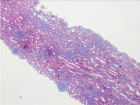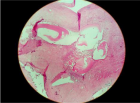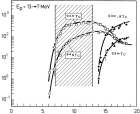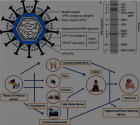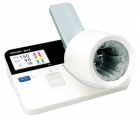Current Issue (Volume - 8 | Issue - 1)
Academic Exposure of Doctors-In-Training in Maiduguri, Nigeria: A Five-year Compendium of Residents’ Presentations
Published on: 6th February, 2024
Introduction: Residency training is built on a tripod of research, training, and services. This is well achieved through academic seminar presentations which are held two to three times weekly. This survey aims to examine the presentations of Resident Doctors for Medical Education.Methods: The presentations from 2017 to 2022 were requested and pooled through a submission point. They were assembled and sorted out based on the presenter’s name, specialties, and year of presentation. Results: The presentations covered all the 12 major subspecialties, with General Adult psychiatry having the highest of 41 (20.5%), while Social psychiatry had the lowest of 5 (2.5%). Only 40% followed presentation guidelines, and 30% were well formatted. Conclusion: Compendium 1.0 is a comprehensive encyclopedia of academic presentations that will aid easy accessibility when needed. It is recommended that sessions on academic writing are regular, including plagiarism, referencing, and using writing software applications.
Emerging Risk of Microplastics on Health, Agriculture and Environment
Published on: 30th April, 2024
Exposure to microplastics is unavoidable, and a vast amount of microplastics are traveling around the oceans. Microplastics are considered one of the major potential pollutants due to their exposure and interference with the health of humans, animals, aquatic species, agriculture, etc. Shockingly, the microplastic was also detected in the human placenta (fetal and amniochorial membranes), which could cause long-term effects on human health. The disposal of plastic into the oceans is the most happening process across the globe; thereby, microplastic pollution is evident, leading to a huge risk to marine species. Also, the accumulation of microplastics on soil or land leads to an increase in pH value, thereby affecting the surface water and soil-groundwater medium, eventually affecting plant and human health. At the same time, microplastics and their particles are found in milk, meat, and other edible items, which directly affects human health. The appearance of microplastic particles in insects, birds, animals, and even human blood indicates its adverse effect on the environment. This review has discussed the impact of microplastic on the health of humans, aquatic species, and agriculture.
Investigate the Effect of Coating Concentration and Coating Thickness on the Anti-microbial Properties of Polycarbonate Sheet
Published on: 29th May, 2024
This paper investigates the effect of coating concentration (ppm), and coating thickness (µm) on the anti-microbial properties of polycarbonate sheets using a variety of anti-microbial agents (Cu-infused Mg(OH)2, Mg(OH)2, Cu(OH)2, MgO, CuCl2.2H2O, and ZnO). In addition, a complete analysis was performed for all agents to rank the best agent in terms of the highest anti-microbial performance against E. coli K-12 MG1655 in two time intervals (4 and 24 hours). The coating concentration (ppm) was found to be a significant factor in the anti-microbial characteristics for Cu-infused Mg(OH)2, Mg(OH)2, Cu(OH)2, MgO, CuCl2.2H2O, and ZnO (p = 0.004, p < 0.0001, p < 0.0001, p = 0.0297, p = 0.0011, and p = 0.0130 respectively). The coating thickness (µm), on the other hand, was found to be a major contributor to the anti-microbial properties of Cu-infused Mg(OH)2, Mg(OH)2, Cu(OH)2, MgO, and CuCl2.2H2O (p < 0.0001, p = 0.0004, p = 0.0011, p = 0.0310, and p < 0.0001 respectively). The analysis determined that the coating did not influence the anti-microbial properties of ZnO. The interaction between the coating concentration (ppm), and the coating thickness (µm) was found to be a significant factor for Cu-infused Mg(OH)2, Cu(OH)2, MgO, CuCl2.2H2O, and ZnO (p < 0.0001, p = 0.0001, p = 0.0004, p < 0.0001, and p < 0.0001 respectively), however, this was not a significant factor for Mg(OH)2.Highlights• The anti-microbial activity of the inorganic material is dependent on the particle shape and size.• Particles with sharp edges will provide additional physical injuries to the microorganisms.• Smaller particle size will provide higher surface area therefore better interaction with microorganisms.• The coating concentration and coating thickness will be crucial to the anti-microbial activity.• The thermal embossing techniques demonstrate good adhesion to the surface.
Relationship between Particle Size, Anti-Microbial Activity and Leachability of Copper Particles in Liquid Suspension and Compounded in Polypropylene
Published on: 29th May, 2024
Testing the antimicrobial efficiency of plastics with good precision and repeatability remains a challenge in the plastic industry, as commonly used standards can provide unreliable data. In this paper, we show that the “Bacterial Liquid Suspension Test” is a reliable method that allows for the measurement of antimicrobial activity of poor to very potent biocides. We used this technique to discriminate the performance of two Cu-based biocides, either in nanoparticle (NP) or macroparticle (MP) size, at three different loadings (0.02, 0.2 and 2 wt.%) in PP. With this technique, we also tested the antibacterial performance of PP as powders, pellets, and injection molded disks. As anticipated, the technique shows that both the increased loading and the smaller particle size showed higher antimicrobial activity than the larger particle size due to their increased surface area. Also, PP powders showed greater bacterial reduction than pellets and disks. While the PP with 2 wt.% Cu NPs showed the best antimicrobial performance, the detection of Cu at the surface (using SEM-EDX) and in the water leachate (using ICP-MS) were below the LODs, indicating their ability to kill bacteria.
Detecting Pneumothorax on Chest Radiograph Using Segmentation with Deep Learning
Published on: 9th July, 2024
Introduction: Pneumothorax is a life-threatening condition that requires prompt recognition and therapy to prevent deterioration. Radiologist workload often precludes rapid assessment of the usual diagnostic modality, the chest radiograph, particularly after hours. The aim was to develop a deep learning model using a segmentation-based Deep Convolutional Neural Network (DCNN) to detect pneumothorax on chest radiographs to provide rapid and accurate pneumothorax diagnosis.Methods: This is a retrospective study of spontaneous pneumothorax at a single center, containing 130 positive and 70 negative radiographs. Subsequent manual contour mapping was performed to draw a mask of the pneumothorax. These image pairs were used to train a DCNN model (a modified AlexNet) after pretraining on the ImageNet dataset.Results: The DCNN achieved an accuracy of 0.83, with sensitivity of 98.1%, and specificity of 68.5%.Conclusion: This segmentation-based DCNN accuracy is comparable to previous categorization-based CDNN models, despite using a smaller sample size for training, while including the benefits of visual representation for clinician feedback. Segmentation-based DCNNs show promise in the development of accurate and clinically useful models for medical imaging.
Relationship between Vitamin D Deficiency and Lipopolysaccharides Porphyromonas gingivalis Bacteria in Stunting Children
Published on: 24th December, 2024
Background: Stunting is a condition of growth and development disorders in children under 5 years of age who appear shorter than their age caused by nutritional deficiencies. The stunted growth and development of children can be influenced by deficiencies in the intake of macronutrients such as protein and micronutrients such as calcium, phosphorus, zinc, and vitamin D. One nutrient that is relevant to current dental health research is vitamin D. Objective: This review article will further analyze the relationship between vitamin D deficiency and Porphyromonas gingivalis bacterial lipopolysaccharide in stunting children. Literature review: Vitamin D deficiency can cause various problems related to the oral cavity such as a decrease in salivary flow rate, buffer capacity, and salivary content such as protein. A decrease in salivary flow rate causes secretory Immunoglobulin A (IgA) to decrease, thus disrupting the colonization of normal microflora in the oral cavity. Reduced vitamin D levels can potentially increase the number of Porpyhromonas gingivalis bacteria and also lipopolysaccharides (LPS), thus inhibiting the proliferation and differentiation of alveolar bone cells. Conclusion: Therefore, lack of micronutrient intake such as vitamin D deficiency can trigger the growth of Porphyromonas gingivalis bacteria and an increase in bacterial products such as lipopolysaccharides, especially in stunted children.

HSPI: We're glad you're here. Please click "create a new Query" if you are a new visitor to our website and need further information from us.
If you are already a member of our network and need to keep track of any developments regarding a question you have already submitted, click "take me to my Query."







